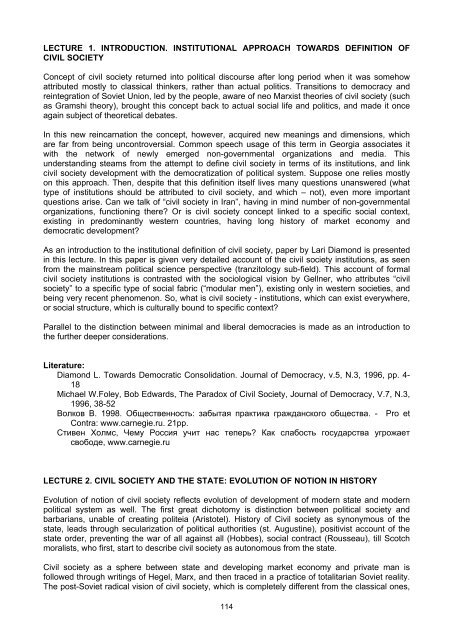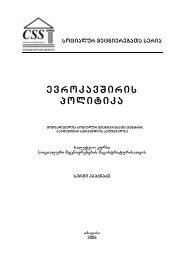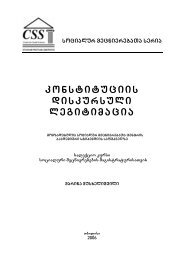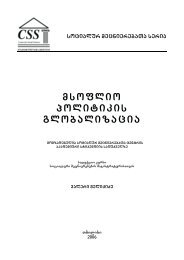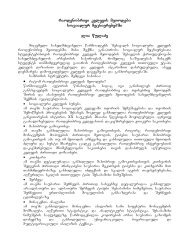samoqalaqo sazogadoeba - Center for Social Sciences
samoqalaqo sazogadoeba - Center for Social Sciences
samoqalaqo sazogadoeba - Center for Social Sciences
Create successful ePaper yourself
Turn your PDF publications into a flip-book with our unique Google optimized e-Paper software.
LECTURE 1. INTRODUCTION. INSTITUTIONAL APPROACH TOWARDS DEFINITION OF<br />
CIVIL SOCIETY<br />
Concept of civil society returned into political discourse after long period when it was somehow<br />
attributed mostly to classical thinkers, rather than actual politics. Transitions to democracy and<br />
reintegration of Soviet Union, led by the people, aware of neo Marxist theories of civil society (such<br />
as Gramshi theory), brought this concept back to actual social life and politics, and made it once<br />
again subject of theoretical debates.<br />
In this new reincarnation the concept, however, acquired new meanings and dimensions, which<br />
are far from being uncontroversial. Common speech usage of this term in Georgia associates it<br />
with the network of newly emerged non-governmental organizations and media. This<br />
understanding steams from the attempt to define civil society in terms of its institutions, and link<br />
civil society development with the democratization of political system. Suppose one relies mostly<br />
on this approach. Then, despite that this definition itself lives many questions unanswered (what<br />
type of institutions should be attributed to civil society, and which – not), even more important<br />
questions arise. Can we talk of “civil society in Iran”, having in mind number of non-governmental<br />
organizations, functioning there? Or is civil society concept linked to a specific social context,<br />
existing in predominantly western countries, having long history of market economy and<br />
democratic development?<br />
As an introduction to the institutional definition of civil society, paper by Lari Diamond is presented<br />
in this lecture. In this paper is given very detailed account of the civil society institutions, as seen<br />
from the mainstream political science perspective (tranzitology sub-field). This account of <strong>for</strong>mal<br />
civil society institutions is contrasted with the sociological vision by Gellner, who attributes “civil<br />
society” to a specific type of social fabric (“modular men”), existing only in western societies, and<br />
being very recent phenomenon. So, what is civil society - institutions, which can exist everywhere,<br />
or social structure, which is culturally bound to specific context?<br />
Parallel to the distinction between minimal and liberal democracies is made as an introduction to<br />
the further deeper considerations.<br />
Literature:<br />
Diamond L. Towards Democratic Consolidation. Journal of Democracy, v.5, N.3, 1996, pp. 4-<br />
18<br />
Michael W.Foley, Bob Edwards, The Paradox of Civil Society, Journal of Democracy, V.7, N.3,<br />
1996, 38-52<br />
Волков В. 1998. Общественность: забытая практика гражданского общества. - Pro et<br />
Contra: www.carnegie.ru. 21pp.<br />
Стивен Холмс, Чему Россия учит нас теперь? Как слабость государства угрожает<br />
свободе, www.carnegie.ru<br />
LECTURE 2. CIVIL SOCIETY AND THE STATE: EVOLUTION OF NOTION IN HISTORY<br />
Evolution of notion of civil society reflects evolution of development of modern state and modern<br />
political system as well. The first great dichotomy is distinction between political society and<br />
barbarians, unable of creating politeia (Aristotel). History of Civil society as synonymous of the<br />
state, leads through secularization of political authorities (st. Augustine), positivist account of the<br />
state order, preventing the war of all against all (Hobbes), social contract (Rousseau), till Scotch<br />
moralists, who first, start to describe civil society as autonomous from the state.<br />
Civil society as a sphere between state and developing market economy and private man is<br />
followed through writings of Hegel, Marx, and then traced in a practice of totalitarian Soviet reality.<br />
The post-Soviet radical vision of civil society, which is completely different from the classical ones,<br />
114


